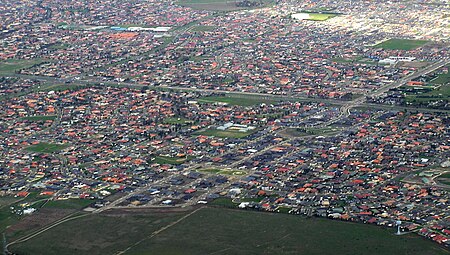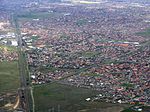Hillside, Victoria

Hillside is a suburb in Melbourne, Victoria, Australia, 24 km (15 mi) north-west of Melbourne's Central Business District, located within the Cities of Brimbank and Melton local government areas. Hillside recorded a population of 17,331 at the 2021 census.There is another locality in Victoria named Hillside, a small rural district near Bairnsdale. The suburb of Hillside was previously part of the neighbouring suburb of Sydenham, however its name was changed to Hillside approximately 18 years ago. It has estates with names of Cypress Rise, Banchory Grove, Parkwood Green, Bellevue Hill, Sugargum Estate, Hillside 2000 and Regency Rise. A large water tower (known as "The Golf Ball" by locals) exists in the estate of The Bellevue, which can be seen from several kilometres around and, along with the large radio transmission towers in nearby Delahey, is a major landmark of the outer north-western suburban area. The streets of Hillside are lined with plane trees, which were planted during the farming days of Hillside. The terrain has a slight slope going up the main street.
Excerpt from the Wikipedia article Hillside, Victoria (License: CC BY-SA 3.0, Authors, Images).Hillside, Victoria
Queens Parade, Melbourne Hillside
Geographical coordinates (GPS) Address Nearby Places Show on map
Geographical coordinates (GPS)
| Latitude | Longitude |
|---|---|
| N -37.687 ° | E 144.743 ° |
Address
Queens Parade 41
3037 Melbourne, Hillside
Victoria, Australia
Open on Google Maps






